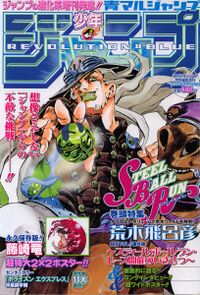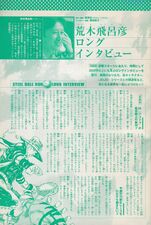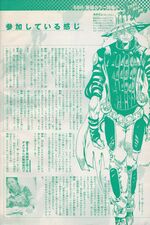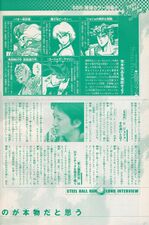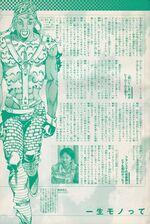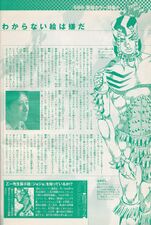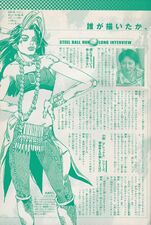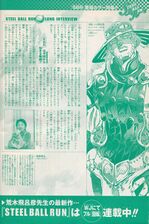Aomaru Jump (February 2004)
Kahoku Shimpo (February 2004)
Interview Archive
Playboy (July 2004)
A long interview with Hirohiko Araki discussing Steel Ball Run from the special edition of Aomaru Jump released on February 26, 2004.[1]
Interview
Long Interview with Hirohiko Araki
Interview and Editing: Kisousha (Yoko Tochino, Yoshihiko Tosawa)
Photography: Hiroko Kikuchi
To commemorate the start of Steel Ball Runs serialization, we embarked on a long interview that lasted over 200 minutes. We asked about everything we wanted to know, including the creation of the story and characters, as well as their relation to the JoJo series!!
"Steel Ball Run is both a new work and an extension of JoJo!"
Your highly-anticipated new serialization Steel Ball Run isn't Part 7 of JoJo's Bizarre Adventure, is it?
Araki: If you've read JoJo Part 6, you'll know that the world came full circle and entered a new world, which is the new setting for the story. But the theme isn't just depicting a parallel world to JoJo. It's just the basic premise of the story, and it has nothing to do with the plot.
Is that why you removed JoJo from the title?
Araki: Yes, it is. But long-time fans are free to consider Steel Ball Run a seventh part of JoJo. In other words, Steel Ball Run is both a new work and an extension of JoJo.
Are Stands going to appear?
Araki: Maybe something like them might appear, who knows? But I'd have the idea behind that kind of prominent ability re-explained from the beginning, and I'd give it a new perspective, so that it wouldn't feel like the same thing again.
It seems as though some fans look at Gyro's steel balls and say, "Isn't that the Ripple?!"
Araki: Ah. They are pretty similar. The idea behind that will be explained in the work, though there may be some pseudo-science involved (laughs).
I'd like to start asking about each character. What was the key point of Gyro's design?
Araki: The costumes of the 1890s might have ended up looking old-fashioned if I drew them realistically, so I gave them a kind of sci-fi appeal, like battle uniforms from the near future.
Gyro's smile was shocking, with those gold teeth of his (laughs).
'Araki: I wanted to bring out an outlaw kind of charm, so that you can tell at a glance that "this guy isn't normal!!" (laughs). 10 years ago or so, piercings and tattoos played that role, but piercings have become standard nowadays, right? That's why I made his teeth gold. In fact, the fashion of Gyro's teeth might be deeply related to his past... I thought it would also cause readers to wonder what kind of past he has, and thereby make the mystery deeper.
Does the "Steel Ball" in the title come from Gyro's steel balls?
Araki: Hmm. You can go with that if you want, but there are two meanings to it. Well, maybe they're connected somehow.
So you're saying you can't talk about that yet... What about the design of the other main character? What's Johnny's key point?
Araki: His background is that he's a former genius jockey, so the horse emblem is his symbol. He's a member of the Joestar family, so maybe he has a star birthmark on his neck (laughs)? The name Johnny is also derived from Jonathan. The bloodline isn't a theme, though, so don't go misunderstanding that. It's just a nod to him being the forefather of a JoJo character. There's no deeper meaning to it.
"I want to draw a race where the qualifying round is impossible!!"
The Dio that appears in this work has a similar aura to the Dio from Parts 1 and 3 of JoJo.
Araki: Yes. He also has a similar background. The difference is that he lives in a world without the Stone Mask (laughs). But I don't think he'll be the main enemy this time. This isn't that kind of story. But Johnny and Dio may end up battling each other.
Steel's hairstyle is unusual.
Araki: Oh, you mean his cap? I didn't want him to be an ordinary man. I wanted him to have the trademark dubiety of a promoter (laughs). But he's also a passionate person and a romanticist. There is also a huge amount of profit involved in the race, so maybe he struggles with that as a character. The fate of Steel is also the fate of the race, so he's a bit like Yūjirō Ishihara from Roar at the Sun!. By the way, my first editor told me to "go into detail with Steel" (laughs).
What about Pocoloco?
Araki: I plan to have him be a formidable foe, but I don't think readers will see him as a "hated villain." It's not a battle between good and evil, and manga that depict races have that kind of enemy in them all the time. I think he'll be a character with a lot of depth.
It feels like a lot of characters wear hats in Steel Ball Run...
Araki: Basically, since everyone is participating in the race, I designed them with rain in mind. If you wear a hat when it's pouring down, you look cooler from behind. And maybe the desert is so hot that I was worried they'd get heatstroke (laughs). Also, hats are an easy way to give a character a distinctive look, just like hairstyles.
They help the characters stand out?
Araki: That's right. Steel Ball Run is about a horse race, so when the characters are drawn from behind, all you see is the horse's butt (laughs), and you have no idea who's riding it. The horses are also designed differently and have various accessories to differentiate them, but if I overdo that part, it starts to become a manga about horses (laughs). That kind of balance is beautiful.
Steel Ball Run's title was announced in the comment at the end of the Weekly Shonen Jump issue with the final chapter of JoJo Part 6, but where did that title come from?
Araki: There's a movie titled The Cannonball Run, which depicts a transcontinental car race, and I named it after that. The plot is completely different, though.
I see. So ``Steel Ball Run is a racing manga.
Araki: That's right. I want to depict the race above all else. But I don't want the race to be one the protagonist has to win, but rather one in which it's unclear who's going to win the whole time. Even the main characters might end up dropping out.
Have you given much thought to how the story will develop in that regard?
Araki: I don't know what's going to happen, either. It feels like I'm taking part in the race myself (laughs).
"It was so hot during my research trip to America, I thought I might die!!"
The first episode of "SBR" starts not with the main character, but with Sandman, which is quite unique.
Araki: Yes. I wanted to deviate a little bit from the usual shōnen manga formula. Also, Sandman played a role in indicating the historical background. If it started with, for example, the race's press conference, you wouldn't know at all whether it was the present, past, or future.
I see. Sandman is a Native American, and when he appears at the start, you can somehow just tell it's the "Western era..."
Araki: Exactly!! Also, if Sandman appears first, then the main characters, Gyro and Johnny, and then he suddenly reappears, I think it will get the readers to start thinking of the story and wonder, "Is Sandman their greatest rival?!" It'll also make it easier to empathize with him.
In order to draw Steel Ball Run, you went on a research trip to America, right?
Araki: I researched San Diego, the starting point of the Steel Ball Run race, as well as the Grand Canyon.
When did you conduct that research?
Araki: I think it was July of last year. I wanted to know what the heat and atmosphere were like at that time of year, so I went there with that in mind. There's no humidity in deserts like San Diego, so even though it was extremely hot, I couldn't sweat at all, and it was quite painful.
Which location left the biggest impression on you?
Araki: Death Valley. I really thought I might die from the heat (laughs).
What was the temperature like?
Araki: I wonder how many degrees it was? But I was told the heat would erase the data on my digital camera, so I think it must've been about 45 °C (113 °F) or so? I thought direct sunlight might be dangerous, so after each photo I took, I quickly put my digital camera back inside my clothes (laughs).
Do you take more photos than videos when you're conducting research?
Araki: Yes, photos. You can't watch a video until later on. With photos, you can just, "slap," spread them out on your desk and look at them right away.
How many photos did you take during that research trip?
Araki: I think I took about a thousand photos over the course of nine days. When I conduct research, I always take six or so photos at each spot. After I take one photo, I take photos from the right and the left of it, then the back and the sky above.
If you put the photos together, it becomes a 360-degree panorama (laughs).
Araki: If I don't take photos like that, even if I know what it looks like from the front, I'll end up wondering, "What was on the right?" And then I'd be in a sticky situation where I'd have to go back and check.
So you don't want to lie about the parts you don't know, right?
Araki: That's right. I want my work to have a sense of reality. After all, the characters are fictional, so I want the setting to be a real place, at least. In that sense, research is very important to me.
"A 31-page weekly serialization is harder than I thought!!
This time around, Steel Ball Run has an amazing 31-page weekly serialization format.
Araki: Basically, each series in Weekly Shonen Jump has a 19-page serialization slot. But in my case, that means I don't have enough pages to keep the story in equilibrium. So after talking with the editorial department, we decided to try increasing the number of pages per issue. Except that I can't physically draw 31 pages a week, so I need to take a break every now and then to recharge.
How did the increased number of pages affect things? The rhythm of the work, and such?
Araki: Hmm. I guess it got a bit tougher (laughs). Rhythm-wise, 19 pages a week suits me better. If it's just 19 pages, I know I can finish it in three days or so. It's not just a matter of numbers, and I can't just go, "It's 12 more pages than before, so I'll just add another day of work."
What do you want to depict in Steel Ball Run?
Araki: The race, of course, as well as the growth of the main character. As for the race, I don't think there'll be any strong evil enemies like Dio or Kira from JoJo. I believe Steel Ball Run is just a bit different from those battle stories. That's why it's a race. In a race, the righteous can fight amongst themselves, and villains can join in as well.
What's the overall theme of the work?
Araki: I think fate is always the theme in my works. Everyone who participates in the Steel Ball Run has nowhere to go except winning the race. From there, when I started drawing the manga and delved into the main characters' motivations, I came to realize that fate is definitely present there.
"What's the difference between Steel Ball Run and JoJo?"
What's the difference between how you've drawn Steel Ball Run and JoJo?
Araki: The story in Steel Ball Run is linear. JoJo is like a web, but Steel Ball Run is a straight line.
Linear, you said?
Araki: Isn't it beautiful? Maybe only the artist would understand (laughs). Anyway, works like JoJo Part 6 became much too complicated, so I've come to value ease of comprehension.
Compared to JoJo Part 1, has your attitude toward your work changed in any way?
Araki: The main theme of an ode to humanity hasn't changed, but I've started to feel like I want to depict the sadder aspects of the characters as well. I'm not as obsessed about the "good vs. evil" concept as I was before, so in that sense, it might be a little different from what's considered mainstream in a shōnen magazine. But if that's something that needs to be accepted as a manga artist grows, then I don't think I need to be so particular about it.
Have you had the plot of Steel Ball Run in mind for a while?
Araki: Yes, in fact. I've generally decided on the themes up to around JoJo Part 9.
Huh? Are you sure we can publish that?
Araki: When I say "Part 9," I don't mean a continuation or anything like that. It's not a saga like Star Wars. The themes and shapes of each story are completely different.
"The Lives of Eccentrics was drawn from a Romantic perspective."
The Lives of Eccentrics is scheduled to be released on March 19th, but did you originally intend to compile it into a single volume?
Araki: No, not at all (laughs). But halfway through, the editorial department told me to start drawing more pages, so I began thinking, "Maybe it'll become a book."
The book will include all six stories that have been drawn so far, right?
Araki: Yes. For that reason, when it came to the contents, I tried not to have a bias toward the same types of characters, or stories about the same tendencies. I thought, "I'd like to have some female characters," so I included Mrs. Winchester, and I also included episodes that don't feel too heavy.
What made you want to draw The Lives of Eccentrics?
Araki: Back in the '80s, I read a lot of books that compiled strange but true stories, and I was interested in the motives of the people involved, asking myself questions like, "Why did this person do this?" I felt it was related to the essence of that person. And after doing a lot of research, I thought, "I want to draw them." It gives me a different kind of courage than drawing people who set sports records.
Did you read those materials to use them as material for your manga? Or were you just genuinely curious?
Araki: Oh, I liked them a lot. Whenever I go to the bookstore, they're always on the same shelves as books about UFOs (laughs).
So you were interested in the kind of human ideal you portray in The Lives of Eccentrics.
Araki: There are some aspects of that. A psychiatrist might say that someone like, say, Mrs. Winchester must be suffering from a disease called something-or-other, and that it's neither Romantic nor trivial, because "that's all it is." I look at them from a different, more Romantic perspective than a psychiatrist's.
"I think people who buy into things are heroes!"
Is there a point to that subject matter?
Araki: There is. I limited myself to people who kept at it their whole lives. People who only do eccentric things temporarily and then give up are no good, because I think something that lasts a lifetime has to be the real deal. To be a hero is to "buy into something." Also, they carry a certain yearning for life.
On the other hand, is there any point that makes you think, "I can't use this character as a subject?"
Araki: There were quite a few characters I had to discard because I thought, "They're an eccentric, but I can't include them in this manga." They might have been too plain as a manga character, or they wouldn't fit the sense of tension. Also, if they did something that I, being human, couldn't forgive, I couldn't possibly include them.
Criminals, for example?
Araki: Even when it comes to crimes, there are forgivable things and unforgivable things in a work. I think people who trample on what's important to us as human beings don't belong in this manga.
Did you decide on the title The Lives of Eccentrics?
Araki: Yes. I wanted a title that would be easy to understand. Although, I was worried that the title might cause people to think, "I'm not eccentric," and make them more reluctant to be interviewed.
So you find it nerve-wracking, depicting real people?
Araki: You have to be very careful. I had to meet with the editorial department all the time to ask, "Is this description okay?" Nonfiction presents an enormous hurdle, and it's quite difficult to overcome it while drawing, so I had to put a lot of effort into drawing The Lives of Eccentrics. But since JoJo was still being serialized, it was physically impossible for me to do the art, so I left the art to Hirohisa Onikubo, one of my assistants at the time.
"The original exhibition in France was really fun!!"
What is the JoJo novel by Otsuichi going to be like?
Araki: It's really interesting. It's reached the level of a full-scale hyper-mystery. For that reason, I think it's better to not make the cover look like a manga. As for the art, I'm fine with drawing the inside illustrations, but I think it would be better if someone else did the cover. I read the version written just after the initial meeting, and it really was quite interesting. Moreover, it seems that the ideas have been piling up since then, and according to my sources, he's constantly been adding more to it. So it might end up being a thick hardcover book. I don't know when it'll be released. It's entirely up to Otsuichi. It's Otsuichi's work completely, Otsuichi's own version of JoJo. I'm looking forward to it too.
In 2003, you held your first overseas solo exhibition in France. But why France?
Araki: I figured that in France, no one would know me. I thought that if people looked at my drawings, they would be able to honestly say whether they found them interesting or boring.
You wanted to try drawing for a place where no one knows you?
Araki: Right. For example, if I did it in Japan, it would be called something like "JoJo's Hirohiko Araki's Exhibition," and Shonen Jump readers would come and see it. But it's not like that overseas, which is nice. People see something walking down the street that makes them think, "What is this art?! I'll have a look inside..." So I thought it would be fun to try it out while on hiatus.
So the location didn't necessarily have to be France?
Araki: Yes, but it's nice to be somewhere where people understand art. Especially the city of art.
What was the reaction like in France?
Araki: I felt that they looked at drawings with the same sensibilities as the Japanese. The responses were the same as in Japan: "The character's expression is great," or, "The pose is nice," or, "How do you think about fashion?" (laughs). That's what was so fun about it. I thought they'd say different things.
What types of age ranges did the visitors fall into?
Araki: Ah. Now that was a little different. From rich ladies wearing fur coats and jewelry to struggling students, men and women of all ages came in. But it seemed like the gallery owner didn't want young people with tattoos (laughs). And old men would ask, "What kind of art is this?" When I answered, "It's the cover of a Japanese manga," they would say, "Japanese comics sure are different from French ones..."
Was the gallery open to the public?
Araki: Yes. And admission was free. I didn't do much advertising. I just made a poster for it and got a little bit of coverage in a magazine.
If you were to hold another solo exhibition abroad, where would you like to go next?
Araki: New York or London might be good. But I've heard New York's tough. For instance, it seems the pictures on display have to be huge. In France, I drew a large picture that was a little over a meter long, but I've heard that in New York, you need at least two meters (laughs). It's really hard to draw something that big. It's about five times the size of a manga manuscript, so I wouldn't know how densely to draw things like the balance of the face (laughs).
"This is the only kind of art I can draw."
You designed a T-shirt for Beams (currently unreleased). The design features Giorno from Part 5 of JoJo and Jolyne Cujoh from Part 6.
Araki: At first, the order was for an illustration that was different from a manga character. Apparently, they wanted to create something that wasn't just a manga character slapped on a T-shirt. But even if, say, I created a new character rather than Giorno, it would still end up being the same thing, because I drew it. In that regard, I thought JoJo would be fine nonetheless. Also, there are times when I don't know who drew a picture, so I wouldn't know what's typical of them. Isn't that the same whether it's a manga character or contemporary art? I just wanted people to ask whether it's good or not, so I thought, "This is the only kind of art I can draw." And so, Giorno and Jolyne became friends.
There are so many JoJo characters. Why Giorno?
Araki: Ah. It's a unisex T-shirt, so it's a boy and a girl. That's all there is to it.
"It's simple" (laughs). Were there any differences between designing a T-shirt and drawing manga on paper?
Araki: Of course there were. It's made of cloth, so I had to pay attention to the seams. Also, I had to make the illustration look like an emblem even underneath a jacket. It was a lot of fun.
What were the difficulties of illustrating the Alex Rider novel series!?
You've also done the cover and inside illustrations for the Alex Rider series.
Araki: An editor at Shueisha asked me if I wanted the opportunity. I'd never illustrated a novel before, so I thought, "I might as well give it a try." At first, it was just one book, but it seemed to be well-received, so a series of books started to come out one after another (laughs).
It was shocking to see the hair on the back of the main character Alex's head in the shape of a Union Jack (laughs).
Araki: I look for room to include my own ideas and put them in. The back of his head wasn't described in the novel, so I had room (laughs).
Did you encounter any difficulties with the illustrations?
Araki: I did. For example, in the novel there's a description of "riding a sand buggy." That's all the text says, but when it comes to illustrating it, there are so many things I don't know, like, "What are the tires of the sand buggy doing?", because it's not a detail I came up with. That's what's difficult about it. Unlike manga artists, novelists might not go into detail about visual descriptions. There are a number of enemy characters who are described as having "short hair," and things like that make me think, "I want to give them a hat or longer hair."
The story of Steel Ball Run begins here and now!!
Aomaru Jump, in which this interview is being published, is a special issue that brings together unique new authors.
Araki: I think it's great when you can tell, just by looking at it, that it's a work by a certain individual. I want to read works by authors with such strong individuality, and I want to buy their books. Personally, I don't like works that lack something distinct on the author's part, no matter how easy to read or interesting they are. I'm sure there will be flaws at first, but as they continue to draw, those flaws will become strengths, so I hope they do their best to bring those out.
Are you speaking from experience?
Araki: Not exactly, but there are some unique writers out there, right? I hope there'll be more of them. Maybe not Eccentrics-level "unique," but I hope they keep at it with hope in their hearts. Even in the world of art, "good but unconventional paintings" aren't recognized until afterward. Even if you're disliked at first, if you have a strong sense of individuality like Van Gogh, you will be recognized later on. I believe it's important that anyone can immediately recognize a Picasso as a Picasso. To me, works with that kind of unique quality are worth it. It won't do any good to imitate someone else and only think about what sells from the beginning, at least as an attitude toward manga.
Finally, please deliver a message to fans of Steel Ball Run.
Araki: I would appreciate if long-time readers didn't read too much into it. We are entering a new world, so I would like you to read it purely as "a story that begins here and now." But the themes of an ode of humanity and the sorrow of fate haven't changed, and I would like to pursue those themes in Steel Ball Run as well.
(Recorded at Araki's house on October 22, 2003 and January 21, 2004.)
荒木飛呂彦ロングインタビュー
取材・構成=樹想社(栩野葉子・戸澤好彦)
インタビュー撮影=菊地寬子
『
『
――待望の新連載『
荒木 『ジョジョ』第6部を読んでいた人ならわかると思うけど、世界が一周しちゃって次の新しい世界に入って、そこが舞台になってるんです。でも『ジョジョ』のパラレルワールドを描くのがテーマじゃないんですよ。物語の大前提っていうだけで、それはストーリーとは関係がないんです。
――だから、タイトルから『ジョジョ』を外したんですね?
荒木 そうです。ただし、昔からのファンの人が『
――スタンドは出てくるんですよね?
荒木 それっぽいのは出てくるかな?でも、ある飛び抜けた能力として理論も最初から説明して、新しい視点でやっていくから「またが」という感じにはならないですよ。
――ジャイロの鉄球の能力を見て「あれは波紋では!?」というファンもいるようですが…。
荒木 あー、ちょっと近いかも。その辺の理論も作品の中で説明しますよ、エセ科学が入るかもしれないけど(笑)。
――各キャラクターについてお聞きします。ジャイロのデザインのポイントは?
荒木 1890年頃の衣装ってリアルにやると古くさく見えるかもしれないので、近未来の戦闘服的っていうかSF的な魅力も加えたコスチュームにしてみました。
――ジャイロの笑顔が衝撃的でしたね、金歯(笑)
荒木 アウトローの魅力が出したかったんですよ。「コイツは普通じゃないぞ!!」って一目でわかるように(笑)。だから10年前くらい前だと、ピアスやタトゥーがその役目をもっていたけど、今の時代だとピアスなんか普通になっちゃってるじゃないですか。だから金歯にしたんですよ。それにじつは歯のオシャレに関しては、ジャイロの過去に深く関係してるのがもしれないし…。読者も「どんな過去なのかな」という謎が深まると思ったんでやりました。
――ジャイロの鉄球ですが、これがタイトルの「スティール・ボール」?
荒木 う〜ん、それでもいいのかもしれないけど、ふたつの意味がかかっているんですよね。まぁ、関係はありますね。
――今はまだ言えない、と…。ではもうひとりの主人公、ジョニーのデザインのポイントは?
荒木 元天才ジョッキーって設定だから馬のマークが象徴です。ジョースター家の人なので首に「星のアザ」もあるんじゃないかな?(笑)ジョニーっていう名前もジョナサンがベースです。ただ血統がテーマじゃないんで、そこは誤解してほしくないんですよ。『ジョジョ』キャラクターの誰かの先祖だとかっていうのは単なる暗示で、深い意味はないんです。
予選不可能なレースをひたすら描きたい!!
――今回登場するディオは『ジョジョ』第1部や第3部のディオと雰囲気が似ていますね。
荒木 そうですね。生い立ちとかも似てます。違う部分は、石仮面(注・つけると吸血鬼に変貌。『ジョジョ』第1部のアイテム)がなかった世界にいるってことかな(笑)。でも今回は最大の敵にはならないと思いますよ。そういう物語じゃないんで。ただジョニーとディオは戦うことになるかもしれない。
――スティールは髪型が奇抜ですね。
荒木 あ、あれは帽子かな?普通の男性にはしたくなかったんですよ。やっぱりプロモーターの怪しさがほしかった(笑)。でも熱い情熱ももっている人で、ロマンチストなんですよ。ただレースには莫大な利益も絡んでくるので、そこで苦悩するかもしれないキャラですね。スティールの運命はレースの運命でもあり、「太陽にほえろ!」の石原裕次郎みたいな存在かな。ちなみに僕の初代担当編集からは「スティールを深く描け」と言われました(笑)。
――ポコロコは?
荒木 強敵になっていく予定だけど、読者的には「憎い悪役」にはならないと思いますよ。善と悪の対決じゃないし、レースを描くマンガにはそういう敵もアリってことで。味わい深い人になると思います。
――『
荒木 基本的にみんなレースの参加者なんで、雨が降った時とかを考えてデザインしたんですよ。雨がザーッて降った時に帽子をかぶっていると、うしろ姿とかがカッコイイし。あと、砂漠地帯はムチャクチャ暑くて日射病になりそうだったからかな(笑)。それに帽子はキャラクターの特徴をつけやすいんですよ、ヘアスタイルと同じで。
――キャラの差別化に役立つ?
荒木 そうそう。『
――『
荒木 自動車の大陸横断レースを描いた「キャノンボール」っていう映画があって、そこからもじってつけました。ストーリーは全然違いますけど。
――なるほど、『
荒木 そうです。とにかくレースをひたすら描きたい。ただ、そのレースも「主人公が勝つ」っていうのではなく「誰が勝つかわからない」っていう感じがいいんですよね。メインのキャラでもリタイアすることがあるだろうし。
――その辺の先の展開は深く考えてはいない?
荒木 何が起こるのかわからないのは僕も同じで。僕自身がレースに参加している感じですね(笑)。
暑すぎて死ぬかと思ったアメリカへの取材旅行!!
――『
荒木 そうですね、少年マンガの定石を少しはずしたかったんですよ。あと、砂男は時代背景を示す役割もあったんで。例えばレースの記者会見の場面から始めちゃったりすると、それが現代なのか過去なのか未来なのか、全くわからないじゃないですか。
――なるほど。砂男はネイティブ・アメリカンで、彼が最初に出ればなんとなく「西部劇の時代」だとわかる…。
荒木 そう!! それと砂男が最初に登増してから主人公のジャイロとジョニ―を出して、その後にパーンと再登場させると「砂男が最大のライバルか!?」っていう読者のストーリーに対する想像が動いたりすると思うんですよね。感情移入もしやすくなるだろうし。
――『
荒木 「
――取材の時期はいつ頃?
荒木 昨年の7月かな。この時期の暑さとか雰囲気が知りたかったんで、狙って行きましたね。サンディエゴとか砂漠地帯は湿気がないから、ものすごく暑いのに汗が出なくてグアーッて感じで、つらかったですね。
――一番印象に残っている場所は?
荒木 デスバレーですね。本当に暑さで死ぬなと思った(笑)。
――気温は何度くらいあったんですか?
荒木 何度だろう?でも「暑さでデジカメのデータが飛んじゃうよ」って言われたから45度くらいあったんじゃないのかな?直射日光がヤバイと思ったんで、写真を1枚撮影するたびにササッとデジカメを服の中に避難させてましたよ〜(笑)。
――取材の時はビデオではなく、写真が多いんですか?
荒木 そうですね、写真です。ビデオだとあとで見直せないんですよ。写真だったら机の上にバーッと広げて、すぐ見られるじゃないですか。
――今回の取材で、写真はどのくらい撮りました?
荒木 9日間で、1000枚くらい撮ってきたかな。僕は、取材だとひとつの場所でも、必ず6枚ぐらい撮るんです。1枚撮影したらその右側と左側、あとはうしろとか空とか。
――つなげると360度のパノラマ写真になると(笑)。
荒木 そういうふうに撮らないと正面がわかっても「右側には何があったっけ?」って気になって「もう1回行かねば」っていう困った事態になるんだよね。
――そのわからない部分は、ウソでごまかしたくないんですね?
荒木 そうですね。僕は、作品にはリアリティが欲しいんですよ。だって、キャラクターは架空の人間ですから、せめて舞台設定は現実の場所がほしいんです。だから、そういう意味もあって、僕にとって取材は大切ですね。
毎週31ページの連載は想像以上に大変だ!!
――今回の『
荒木 WJ(ウィークリー・ジャンプ)って基本的に連載枠が1作品19ページなんです。でも、それだと僕の場合、ストーリーの兼ね合いとかでページがどうしても足りないんですよ。で、編集部と相談した結果、1回のページ数を増やしてみようという話になったんです。ただ、肉体的に1週間に31ページも描けるわけではないから充電期間が必要になるんですけどね。
――ページ数が増えるとどうですか?仕事のリズムとか。
荒木 うーん、ちょっとつらいですかね(笑)。リズム的には週刊連載で19ページを描いていくほうが合っているんですよ。19ページくらいなら「あと3日くらいで終わるかな」ってわかるんだけど。「今までより12ページ多いから、あと1日増やせばいい」といった単なる数字の問題ではないですね。
――『
荒木 やはりレース、それから主人公の成長ですね。レースに関しては『ジョジョ』のディオとか吉良みたいな悪の強敵は出ないんじゃないかな。『
――作品全体のテーマは?
荒木 自分の作品の中には常にあるのは「運命」、それがテーマじゃないかな。『
『
――『
荒木 『
――直線的…ですか?
荒木 麗しい?描いている人じゃないとわからないかも(笑)。とにかく『ジョジョ』の第6部とか複雑になりすぎたところもあるので、わかりやすさを大切にしてます。
――『ジョジョ』第1部の頃と比べて、作品に対する姿勢が変わったりした部分はありますか?
荒木 「人間賛歌」っていう大きなテーマは変わっていないけど、キャラクターの悲しい部分とかも描きたいっていう気持ちが出てきましたね。「善対悪」の図式も昔ほどこだわらないし、そういう意味では少年誌の王道とは、少し違っているのかもしれないけど、でもそれがマンガ家の成長として仕方ないことだったら「特にこだわらなくてもいいのかな」と思いますし。
――『
荒木 そうですね。だいたい『ジョジョ』第9部くらいまではテーマを決めているんですよ。
――えっ。それは載せちゃって大丈夫なんですか?
荒木 第9部って言っても「続く」と言うことじゃないんで。『スターウォーズ』みたいなサーガではないんですよ。テーマも物語の形態もまるで違うし。
『変人偏屈列伝』はロマンチックな視点で描く
――3月19日発売予定の『変人偏屈列伝』ですが、これはもともと1冊にまとめるつもりだったんですか?
荒木 いや、全然(笑)。ただ途中から「ページ数がたまるように描いてね」って編集サイドから言われてたんで「単行本になるかなぁ」とは思ってました。
――単行本には、これまでに描かれた全6話が収録されるんですよね?
荒木 そうです。だから内容的にもキャラクターの種類っていうか、同じ傾向の話に偏らないようにしました。「ちょっと女性もほしいな」ってことでウインチェスター夫人を入れてみたりとか、あまりヘビィな感じにならないようなエピソードも入れたりして。
――『変人偏屈列伝』を描こうと思ったきっかけは?
荒木 そもそもは80年代の頃に、変な実話を集めた本とかをたくさん読んでいて「この人は何故こんなことをしたのか?」という動機の部分が気になってたんですよ。それが、その人の本質に関わっているって感覚があって。で、いろいろと調べていくうちに「描きたい」と。スポーツの記録をうち立てた人を描くのとはまた違った勇気が湧いてくるんですよね。
――資料の類はマンガの題材になるから読んでいたんですか?それとも、もともと気になっていて?
荒木 あぁ、好きなんですよ、本屋さんに行くとUFOとかの本と同じ棚に置いてあるようなのが(笑)。
――『変人偏屈列伝』で扱われているような人間像に興味があったわけですね。
荒木 そういうところはありますね。ウィンチェスター夫人みたいに屋敷を増築し続けている人を、例えば精神科の先生は「これはナントカって病気ですね」って言うんだけど、それじゃロマンもへったくれもない、「それ言ったらお終いだろう」ってのがあって。精神科医の視点とは違う、もっとロマンチックな視点で僕は見てるんですよ。
「買いている」のがヒーローだと思う!
――題材のポイントはあります?
荒木 ありますよ。「一生を通じてやっていた人」に限ってるんですよ。一時期だけ変わった行動に走った人はダメなんですよね、一生モノってのが本物だと思うんで。「買いている」ってのがヒーローなんですよね。あと、生きることの恋しさを背負ってるんで。
――逆に「この人物は題材にできない」っていうポイントはありますか?
荒木 「変人だけど、このマンガには入れられないなあ」って没にする人物も結構いますね。マンガのキャラクターとして地味っていうか、サスペンスにそぐわなかったりして。あとはやはい人間的に許せないことをしてる場合は入れられないです。
――それは例えば犯罪者だったり?
荒木 犯罪でも、作品的に許せるものと許せないものがあるんですよ。人間として大事なものを踏みつけているような人物は、このマンガにはちょっと入らない人たちかなって思うんです。
――『変人偏屈列伝』というタイトルは先生が決めたものですか?
荒木 そうです、「わかりやすいタイトルがいいな」と思って。ただ、このタイトルだと「俺は変人じゃあないぞッ」って取材とかを嫌がる人もいるかなって危情はありましたけど。
――やはり、実在の人物を描くのは神経を使いますか?
荒木 すごく気を使いますね。編集サイドとも「この表現は大丈夫だろうか?」って打ち合わせはするし。ノンフィクションっていうのはスゴい壁があって、それを乗り越えながら描くのは結構大変ですね。でもその分、「変人偏居列伝」はすごい思い入れっていうか力を入れて描いたんですよ。だけど『ジョジョ』の連載中は、作画までやるのは物理的に不可能だったんで、アシスタントをしてくれていた鬼窪浩久先生に作画をお任せしたんです。
フランスでの原画展はとても面白かった!!
――乙一先生の小説版『ジョジョ』はどうなっているんでしょう?
荒木 あれね、かなり面白いんだよねー。本格ハイパーミステリーみたいな、そういうレベルの内容ですよ。だから表紙なんかもね、マンガっぽくしないほうがいいと思うし。イラストも、挿絵は僕が描いてもいいけどカパーは違う人のほうがいいんじゃないかとか思ってます。最初に打ち合わせして書かれたバージョンを読んだけど、かなり面白かった。しかもそれから、またアイデアがガンガン出てきたみたいで、どんどん書き足してるらしいよ、情報によると。だからハードカバーの分厚い本になっちゃうかも。で、いつ発売になるかはわからない。乙一さん次第っていうか。これはもう完全に乙一さんの作品で、乙一版『ジョジョ』だよ。僕も楽しみなんだよねー。
――2003年は、フランスで初の海外個展を開催されましたね。でも、何故「フランス」なんですか?
荒木 フランスだったら、みんな僕のことを知らないだろうと思ったんですよ。純粋に絵を見てもらって「面白い」「つまらない」っていうのが率直にわかるんじゃないかなと思って。
――誰も知らない場所で自分の絵を試してみたかった?
荒木 そう。例えば日本でやっていたら。「『ジョジョ』の荒木飛呂彦原画展」になるし、ジャンプ読者が来てくれるじゃないですか。でも、そういうのじゃないのがいいんですよ、海外は。道を歩いてて「なんだこの絵は!? ちょっと入ってみようか」ってのが見たかったっていうか。休暇のついでにやってみようかな〜ってことで。
――じゃあ場所はフランスじゃなくても良かったんですね。
荒木 そうですね、ただ絵がわかる人がいる場所がいいんですよね。アートの街がいい。
――フランスでの反応はいかがでした?
荒木 「日本人と同じ感覚で絵を見ているなあ」って思いました。「キャラクターの表情がいい」とか「ポーズがいい」とか「ファッションはどうやって考えるんだ?」とか、質問がね、日本と同じなの(笑)。そういうのが面白かったっていうか。もっと違うところを言ってくるかなって思ってたんですけど。
――お客さんの年齢層はどうでした?
荒木 あっ、そこはちょっと違ってた。毛皮とかジュエリーを身につけたお金持ちのご婦人から苦学生まで、老若男女、全部来てくれるんだよね。ただ画廊の人は、タトゥーを入れた若者とかには来てもらいたくないみたいだったけど(笑)。で、おじいちゃんとかが普通に聞いてくるの、「これはなんの絵だ?」って。「日本のマンガの表紙だ」って答えると「日本のコミックはフランスのものとは違うんだな」って言ってくれたり。
――画廊は誰でも自由に入れるスタイルだったんですか?
荒木 そう。入場も無料だし。宣伝もほとんどしなかったんですよ、ポスターを作ったのと雑誌に少し紹介してもらったくらいですね。
――もし次回、また海外で個展を開くとしたらどこがいいですか?
荒木 ニューヨークとかロンドンがいいですね。ただニューヨークはね、手強いらしいですよ。例えばディスプレイ用の絵も大きくないといけないらしくて。フランスの時も1メートルちょっとある大きな絵を描いたんだけど、ニューヨークは2メートルは必要って話だからさー(笑)。大きいとすごく描きにくいんですよ。マンガ原稿の5倍くらいあるから、顔のバランスとかどういう密度で描いたらいいかわかんないの(笑)。
僕にはこういう絵しか描けない
――BEAMS TでTシャツのデザインをされましたね(注・現在は販売されていません)。絵柄が『ジョジョ』第5部のジョルノと第6部の徐倫で。
荒木 最初はね、マンガのキャラクターとは違うイラストっていうオーダーだったんです。「マンガのキャラクターTシャツではないもの」を作りたかったらしいんですよ。でも例えばジョルノではなく新しいキャラクターを作って描いても、僕の絵なんだから結局は同じになったと思うんですよ。だったら『ジョジョ』でもいいだろうって。それに誰が描いたか、わからない絵は様だったっていうことはあります。「マンガのキャラクターだろうが現代アートだろうが同じじゃないかな」って思うし、やっぱり「良いか悪いか」ってところで見てほしいから「僕はこういう絵しか描けません」ってことでジョルノと徐倫になったんですよ。
――『ジョジョ』キャラクターは数多くいますが、何故ジョルノとに?
荒木 ああ、男女共用のTシャツなんで男の子と女の子。ただそれだけなんですよ。
――シンプルですね(笑)。それで、Tシャツのデザインは、紙に描くマンガと何が違いましたか?
荒木 ありましたね。布だから縫い目の事を考えたりとか。あと、上着を着た時でもイラストがエンブレムっぽく見えるようにしたりとか。面白かったですね。
小説『アレックス』シリーズ、挿絵ゆえの難しさとは!?
――「女王陛下のスパイノアレックス」シリーズのカバーイラストや挿絵も担当されていますね。
荒木 集英社の編集さんから「やりませんか?」って声がかかったんですよ。僕は小説の挿絵って描いたことがなかったんで「やってみようかなー」って。最初は1冊だけって話だったんだけど、評判が良かったみたいで次々とシリーズが出ちゃって(笑)。
――主人公・アレックスの後頭部が衝撃でした、髪の毛がユニオンジャックになっているっていうのが(笑)。
荒木 自分なりのアイデアが入る余地を探して入れるんですよ。小説に後頭部の描写がなかったからやりました(笑)。
――挿絵ゆえの難しさはありますか?
荒木 ありますね。例えば小説に「サンドバギーに乗っている」という表現があるじゃないですか。文章だとそれだけなんだけど、絵にするには「サンドバギーのタイヤってどーなってんの?」とか、自分で考えた設定じゃないからわからないところがあるんですよ。そこが大変。小説家ってね、マンガ家と違ってビジュアル面の描写はあまりしないかもしれないですね。「短く髪を刈り込んでいる」って表現の敵キャラが何人も出たりするので、そういう時は「帽子をかぶせたり長髪とかにしたいなー」って思います。
『
――このインタビューが掲載される「青マルジャンプ」は、クセのある新人作家を集めた増刊なんですよ。
荒木 「この人の作品だ」って見ただけでわかるのって、すごく感じがいいと思うんですよ。個性が強い作家さんの作品を読みたいと思うし、本を買いたいと思うんだよね。いくら読みやすくて面白くても、作家性のない作品は個人的にはあまり好きじゃないです。最初のうちは欠点とかあるとは思いますけど、描き続けていくうちに長所になっていきますので、頑張ってそこを押し出してほしいと思いますね。
――それは体験上のアドバイス?
荒木 そういうわけでもないんですけど異色の作家っているじゃないですか。そういう人がもっと増えてほしいですね。『変人個屈列伝』じゃないですけど希望をもって「やり続けてほしい」ですね。絵画の世界でも「上手だけどクセがない絵」というのは結果的には評価されないんですよ。最初は嫌われていても、ゴッホみたいに強烈な個性があると後になって評価されるし、ピカソみたいに誰が見てもすぐに「ピカソだ」とわかるっていうのは大切だなと。そういうクセのある作品がいいと思いますよ、僕は。最初から誰かの真似をして売れることだけを考えるってのは良くないんじゃないかと思います、マンガに対する姿勢として。
――それでは最後に、『
荒木 古くからの読者には、深読みはしないでほしいって思います。新しい世界に突入しているんだし、純粋に「今回から始まる物語」として読んで欲しい。でもテーマは変わっていなくて「人間讃歌」や「運命の悲しさ」で、『
(2003年10月22日及び2004年1月21日、荒木先生のご自宅にて収録)
